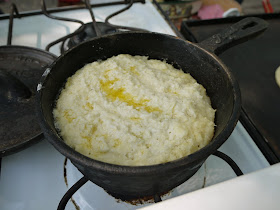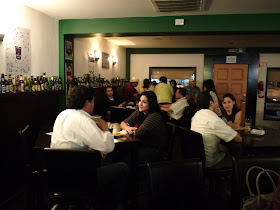
The fearless chef Patricia Quintana braves the cascading waters at Parque Cola de Caballo, Santiago, Nuevo Leon.
At the end of May I reunited with Aromas y Sabores, the northern route, and chef Patricia Quintana in Monterrey, Nuevo Leon. After a relaxing dinner the night before at a cozy spot in downtown, and a rekindling of new friendships from the inauguration back in Mexico City, I was ready to taste the north!
I made it a goal to interact with everyone on two full buses during the next couple weeks--not easy with such a broad range of people, and so many cliques that had forged during the week I missed. With such intense travel and profound experiences, I felt like a kid who wasn't around for the 10th grade and returned to a high school that wasn't anything like the place I had left. I was the new kid, and the only pocho among mostly chilangos and spaniards. In the end my efforts would pay off, and the friendships and acquaintances made on this trip were as valuable as the knowledge acquired, and shall remain a fountain of inspiration.
Our morning commenced with an early departure to Santiago; just outside of Monterrey. The side of the road held signs of new tastes to come. I saw things like tacos mañaneros, grilled meat stands featuring sweeetbreads, empalmes(first time I had seen this word), and new regional guisados(stews). In Mexico, the local foods are all around the roads and streets; all you need do is look out your window.

Santiago, known as the Pueblo Magico(magical town), is full of natural beauty, ecotourism, and great cuisine. It's a place to relax and partake in mountain climbing and hiking in Chipinque Park, cycling, rappelling, camping, and to enjoy the picturesque mountains and waterfalls. Locals head out to La Presa de La Boca, a reservoir, for water sports and excursions by horse-back.

Machacada con huevo, local beef jerky with eggs.
We were received at the Hotel Hacienda Cola de Caballo(horse's tail--the waterfall looks like a horse's tail) by the local tourism representatives, a proud peacock(one of the local attractions), a breakfast buffet consisting of local flavors, and the lovely Reina de Las Ferias y Turismo Santiago: Tanya Silva. Everything is better with beauty queens; not to mention they're quite knowledgeable about their communities in a refreshing, non-partisan manner.
One of the highlights of our breakfast extravaganza was the machacada con huevo--one of the most amazing bites one can have wrapped in a flour tortilla. The Nuevo Leon style of dried beef isn't available in the US, and has a different taste than that of the Sonoran variety. Any machaca that makes it to LA usually come from Sonora--this was a rare treat.

The reigning queen of Santiago tourism, Tanya Silva, was beaming with charm, warmth and grace. She described her city as a place to relax and take in the natural beauty plus she turned me on to a couple of local dishes: pollo en salsa, and the famous rotisserie chicken at Pollos Guzman. Pollo en salsa is another local dish I didn't know; I was really starting to get a feel for Nuevo Leon. I enjoyed learning from her about Santiago: no alterior motives,no agenda, just a desire to share her love for Santiago, and be a great hostess. From here on out, I'm looking for the beauty queens!

On our way from breakfast to the waterfall we encountered some local vendors--I went light on breakfast to have space for such an opportunity. A bean dish was called Laurita Mexicano by the woman preparing the food, but I'm not sure this is accurate. It could be cowboy beans or chile con carne. Regardless of name; the bayo beans with tomato, tiny chunks of beef, onions and peppers delighted our senses with its well-seasoned northern tang.

Most of our group huddled hungrily around Comidas Maria Elena, a stand that has endured 50 years at the Cola de Caballo. They had 6 mouth-watering guisados(stews) for griddled gorditas(corn masa pockets), pan de elote(corn bread), and tamales.

Nopales con tortitas de camaron, or cactus with shrimp patties. As we learned on this trip, many dishes have the same names throughout Mexico, but the chiles, and other key ingredients change as to render them entirely different.

The picadillo had large cubes of local potatoes giving them a more hearty appeal than southern recipes.

Deshebrada de res, or shredded beef.

Asado rojo and asado verde are the local guisados at Comidas Maria Elena that captured my attention. Lusty stews glistening with pork fat and colored by the bled skins of regional chiles. The gordita of red pork was given additional flavor by a salsa of chile japones(Japanese chiles).

In the historic center of Salinas we were greeted by a children's choir and a food fair featuring local tastes.
But first I slipped away for a quickie with some tacos mañaneros, or morning tacos. These are known as tacos de guisado, or tacos al vapor in other parts of Mexico. They're tortillas filled with stews and braises of the provincial affection.
Tacos Valdez has been around for 15 years in Salinas, serving the "tacos of the morning" from 7AM-3PM, Monday through Saturday.

Each day a variety of fillings are prepared, and some chiles rellenos, too, also to put in tacos.

The barbacoa in Nuevo Leon is a braise of beef, traditionally cooked underground. The taco of barbacoa at Tacos Valdez is sublime. I also took this quick stop as a chance to get to know the famous machacada con huevo a little more.
I found so many gems on this trip sneaking away from the group, but two tacos was all I could fit in for fear of the bus leaving without me. But, I highly recommend Tacos Valdez when visiting Santiago.

In the town square I sampled some mezcals and liqueurs from Nuevo Leon.

And if you thought that banana leaf tamales only existed in southern Mexico, think again. In addition to tamales de elote, and corn husk wrapped tamales, we tasted tamales colados of pork head stewed in red chiles.

Pan de elote, or corn bread cooking at the Cola de Caballo.

The sweet pan de elote, also called gorditas de elote on the ranches, is made with tender corn, vanilla, eggs and condensed milk.

Another unusual item from Santiago: turcos, or Turks--they're empanadas filled with various sweets. Turcos Santiago is one the most respected bakers of turcos--give them a try.

Nuevo leon is also a state of incredible panaderias with it's own unique forms of pan dulce, or sweet bread: turcos,semitas,polvorones, hojarascas, and the aforementioned pan de elote.
It would be later in the day--yes we did three cities this day including our evening back in Monterrey--that I would get my first taste of pollo en salsa and empalmes, but already Nuevo Leon impressed. I had visited Monterrey several times, but Salinas is an entirely new perspective on Nuevo Leon, and on Mexico. It's safe to say I fell in love with another town, another set of flavors, and the people. I shall return.
Santiago should be on your list of destination in Mexico; it's off the beaten path where you can enjoy an unspoiled Mexican experience.
Stay tuned for the next stop on Aromas y Sabores, la ruta del norte: Allende, Nuevo Leon.
For more information on Santiago, Nuevo Leon please visit their website here.
Aromas y Sabores, la ruta del norte 2011
Santiago, Nuevo Leon



























